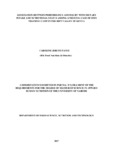| dc.description.abstract | Kenyan athletes are renowned over the world for their endurance running in middle and long distance races. They have won approximately 40% of all major international long and middle races that they have participated during the last decade. However, athletes sometimes get injuries which affect their performance and as a result have dropped out of the competition. The injuries are presumed to be nutrition related and may result from a negative energy balance and inadequate dietary intake particularly the micronutrients iron and calcium. This study was therefore designed to assess the association of performance of athletes with dietary intake of energy, iron and calcium in a training camp setting. The study was cross sectional in design and was conducted in Iten training camp Elgeyo-Marakwet County of the Rift Valley of Kenya. A sample of 282 athletes was used for the study, consisting of 192 males and 90 females. Iten training camp was purposively selected because of the regularity of training. Proportionate to size sampling was used to select athletes according to their races. A pre- tested structured questionnaire was used to collect data on socio demographic and socio- economic characteristics, level of performance and frequency of injuries. A 24-hour recall was used to determine the dietary intakes of energy, iron and calcium. Anthropometric measurements of weight and height were used to determine nutritional status of athletes as BMI. Nutri- survey software and Kenyan National food composition tables were used to compute the energy, calcium and iron intakes by individual athletes. SPSS 20.0 software was used for analysis. Results were subjected to analysis as frequencies, percentages, chi – square, linear regression and logistic regression. Results showed that majority of athletes have secondary education; males at 60.4% and females at 55.6%. Almost half of the athletes were middle class socio economic category with males at 48.9% and females at 44.4%. Most of athletes were self employed with a few of them being employed in the armed forces of Kenya. Male athletes dominated long distance races like
xiii
marathon and half marathon at 64.5% whereas most of the female athletes were in middle distance races at 47.8%. Dietary intake of female athletes was lower as compared to those of males whereby 34.8% of male athletes met the RDA for energy and only 6.3% of females met the RDA for energy. None of the female athlete met the RDA for iron. The average individual Dietary Diversity Score was 4.34 with most consumed food group being starchy staple. Nutritional status of athletes was poor, female athletes were more likely to be underweight than males. A chi square test was done with a P value of 0.047 indicating that majority of the female athletes were underweight compared to the male athletes. Injuries were also quite common and female athletes were 5.8 times more likely to suffer injuries than the male athletes. Results concluded that there was a significant positive association between performance and dietary intake of energy, iron and calcium. Athletes experienced injuries, loss of breath and fatigue which were the major hindrances to performance due to inadequate dietary intake of energy, iron and calcium. It was established that athletes had inadequate dietary intake of energy, iron and calcium with more of the female athletes not meeting the recommended dietary intake. The overall nutritional status of athletes as measured as BMI was poor. | en_US |



